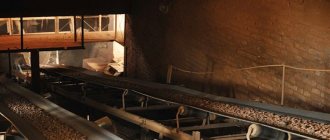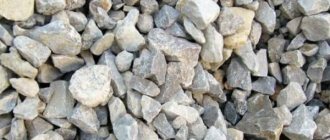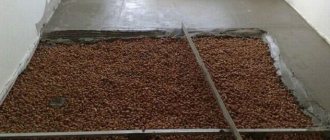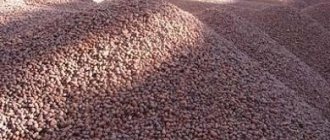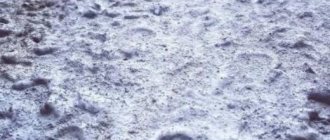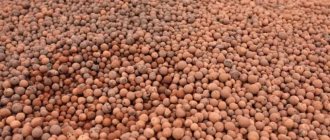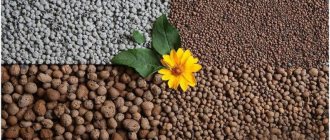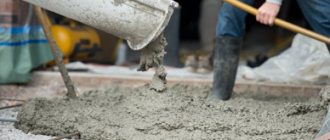- August 19, 2019
Modern construction technologies do not stand still; new, more advanced materials are constantly coming into our lives.
Science is constantly working to reduce the weight of the material, increase its performance characteristics and minimize the cost. The aspect of thermal conductivity is especially important - both in cold climates and in hot ones. In different climatic zones, the issue of keeping warm is always on the agenda; no one wants to freeze. One of such materials, on a global scale, is expanded clay. They learned to produce it relatively recently; thanks to its heat-insulating properties, it has become in demand everywhere.
Expanded clay: composition and properties of the material
Like many other interesting finds, expanded clay was invented by accident, at the dawn of the 20th century. At first, burnt and swollen bricks were considered defective and simply sent for scrap. And a little later they came to the conclusion that such a hard and fairly light material can be added to concrete in order to lighten the load-bearing structure.
And only in the 30s of the last century, the Soviet engineer Onatsky tried to make balloons from clay and fire them in special rotary kilns. As a result, solid baked clay granules saw the light of day, which found wide application in construction.
And could it be otherwise, given that this material does not deteriorate over the years, is resistant to frost, does not burn and does not emit harmful compounds into the atmosphere? In addition, with a bulk density of 200 kg per 1 cubic meter. Expanded clay has a thermal conductivity coefficient of 0.16 W/(m*k).
Typically, the formation of expanded clay from various types of clay occurs at a temperature of 1100-1300°C. Moreover, the duration of heating of the clay is also important, because the fraction of the final product, and therefore the weight of the product, depends on these parameters. It can vary from 250 to 800 kg/m3.
Various expanded clay manufacturing technologies have made it possible to obtain several types of products, in particular:
- Expanded clay gravel. These are the same expanded clay balls that the modern construction industry is focused on producing. Gravel has a round shape with a fraction from 5 to 40 mm. At the same time, the product has a classic red-brown color.
- Expanded clay crushed stone. This material has a similar fraction from 5 to 40 mm. And the main difference between crushed stone and expanded clay gravel lies in its shape. The fact is that crushed stone is obtained by splitting expanded clay into pieces. The result is a sharp, irregularly shaped product that is most often used as an additive to concrete mixes.
- Expanded clay sand. This is expanded clay with the smallest fraction, not exceeding 5 mm. What is characteristic is that it is not specially produced. It is a by-product of the production of larger material.
How to insulate a roof with expanded clay
Since expanded clay is a bulk material, the technology for insulating a flat roof or floor and pitched roof is different. At all stages except preparatory.
Tools and materials
To insulate a roof with expanded clay, you need standard tools that every home craftsman and householder has:
- screwdriver;
- construction knife;
- hammer;
- tape measure, pencil and building level;
- a scoop that will be convenient for scooping up expanded clay;
- rule (can be replaced with a flat board);
- bucket.
Materials you will need:
- expanded clay sand, expanded clay gravel of fractions 5-10 mm and 10-20 mm in proportions 1:4:5;
- edged board with a thickness of 20-25 mm (for insulating the ceiling with expanded clay, it is replaced with timber 20×20 mm or 25×25 mm);
- vapor barrier;
- waterproofing membrane;
- wood screws, dowels, if the boards need to be attached to the concrete floor;
- reinforced tape;
- marking thread.
Boards and timber must be treated with an antiseptic and fire retardant and allowed to dry. If the roofing has already been installed, insulation of the attic with expanded clay is carried out only along the ceiling. It is impossible to attach the lathing for filling expanded clay from the inside to the rafters - under the weight of the material, the fastenings will weaken over time, which can lead to spillage of the insulation between the cells and even its avalanche-like descent with damage to the roof structure.
What layer of expanded clay is needed to insulate a house?
As when working with other types of heat-insulating materials, when insulating with expanded clay, the thickness of the layer depends on the standard value of the structure’s heat transfer resistance R, which is calculated according to SP 50.13330.2012 “Thermal protection of buildings.” In short, the R value depends on the type of structure and building, as well as the climate in the area where it is being built. This value must be calculated in the design documentation. If this is not the case or you are insulating the house with expanded clay without a design, then the required heat transfer resistance will have to be calculated independently.
With known R, you can determine which layer of expanded clay for insulation is needed in your case using a simple formula:
P=Rk
where P is the layer thickness in meters, and k is the thermal conductivity coefficient of expanded clay, which can be viewed on the packaging or obtained from the manufacturer. If this is not possible, the thermal conductivity coefficient is taken equal to 0.16 W/(m K).
For those who do not want to do calculations, we present the average values of insulation thickness in different situations. So, what layer of expanded clay is needed for insulation:
- in the southern regions - 20-25 mm;
- in central Russia for flat roofs - at least 40 mm;
- for a pitched roof - no more than 30 mm; if greater thickness is needed, it can be obtained with other types of insulation;
- for overlap - at least 30 mm, preferably 40 mm.
When making calculations, do not forget that the thickness of expanded clay insulation depends not only on the value of the required heat transfer resistance of the structure, but also on the bearing capacity of the foundation, walls and rafter system of the house. In this case, it is necessary to take into account the snow load, which even in the central zone of the Russian Federation, not to mention the northern regions, reaches hundreds of kilograms per unit area. Therefore, in the northern regions, expanded clay is usually not used for insulation.
How much expanded clay is needed for insulation?
You can calculate how much expanded clay you need to insulate a roof or attic floor using the formula:
V=h·S·n
where V is the volume of expanded clay in m3, h is the calculated thickness of the expanded clay layer in m, S is the insulation area in m2, n is the correction factor, which is taken equal to 1.05-1.2. This coefficient takes into account the shrinkage of expanded clay during its compaction.
The value of the correction factor depends on what exactly you want to insulate:
- for attic floors n=1.05;
- for pitched roofs n=1.1;
- for flat roofs n=1.2.
If there is such an opportunity, it is better to buy expanded clay with a margin of an additional 5-10%. The fact is that expanded clay in bulk and in large bags is several times cheaper compared to packages of several tens of liters that are sold in construction and gardening stores. The difference is so significant that it is often more profitable to buy extra hundreds of liters than to later buy the missing volume of expanded clay in small packages. In addition, in a private house, excess expanded clay can always be used for drainage of indoor plants or for constructing alpine slides.
Insulation of attic floors with expanded clay
Before starting work, the surface must be prepared: remove all debris and dust, seal uneven areas and cracks, if any. If you do not close the cracks, then no matter how much expanded clay you lay on the floor, a lot of fine dust will get into the living room, which will be difficult to remove.
Insulating the floor with expanded clay begins with laying a vapor barrier, which is installed with an overlap. The film must extend 20-25 cm onto walls and other structures. Places of overlap and joints of the vapor barrier with enclosing structures are carefully taped with reinforced tape. If the film is attached to the ceiling with paper clips or nails, the fastening points must also be sealed with tape.
A frame is made on top of the vapor barrier layer to fill the expanded clay. It is made of timber, which is attached in one or two rows.
When installing timber in one row, it is fastened in increments of 1-1.5 m. In this case, the thickness of the timber depends on what layer of expanded clay is needed for insulating the ceiling. For example, if the calculated insulation layer is 40 mm, then a 20×40 mm or 25×40 mm beam is used to install the frame. A single-row frame is easier to install, but in this case, each beam will be a cold bridge through which heat will leave the room below. To avoid this, the frame is made double-row.
For a two-row frame, take a beam whose thickness is equal to half the calculated thickness of the expanded clay layer for insulation. The first row is also fastened every 1-1.5 m, after which the gap between the planks is covered with expanded clay. Then a second row of timber is installed, which is fastened perpendicular to the first with the same pitch. This allows you to pour expanded clay onto the beams of the first row and almost completely remove cold bridges - they will remain only at the intersection points of the frame beams.
Regardless of what expanded clay you decide to use for ceiling insulation, backfilling of insulation always begins with a leveling layer of expanded clay sand. Typically its thickness is 5 mm. To spread the sand in an even layer, in the middle of the gap between the bars, a nylon thread is pulled parallel to them at the desired height. Then the sand is poured between the bars, compacted and leveled using the rule.
To make the insulation layer dense, the expanded clay gravel fractions are mixed. This is done either in a bucket or other container before filling, or a ready-made expanded clay mixture is ordered at the factory. Gravel is poured between the beams in a layer of 10-12 cm, compacted, then the same layer is poured again and compacted again until the required insulation thickness is achieved. The completely poured layer of expanded clay is leveled using the rule, using the upper edges of the frame as beacons. At this stage, insulation can be completed if the attic is not planned to be used for storing things and other tasks. If there are such plans, then you need to make a flooring on top of the expanded clay.
Before installing the flooring, the expanded clay is covered with another layer of vapor barrier according to the same rules: with an overlap, sealing the joints with reinforced tape. A boardwalk is made on top of the vapor barrier, using frame beams for support and fastening.
Insulation of a flat roof
Vapor barrier film is usually not used on a flat roof - if it is accidentally damaged when filling in expanded clay, the roof will begin to leak. Instead of film, the roof surface is first coated with two layers of primer. It is needed to increase the adhesion of bituminous materials to the concrete base.
Then bitumen mastic is applied to the primer, and bitumen roll waterproofing is applied on top of it. Another waterproofing option is self-leveling roofing. This coating is monolithic, elastic and very durable, so leaks are practically excluded. But self-leveling roofing is more expensive than conventional rolled bitumen coatings.
Next, they begin pouring expanded clay. The principle of backfilling is the same as for overlapping: first expanded clay sand, then mixed fractions of expanded clay gravel in layers of 10-12 cm and compacting them. Only on a flat roof a frame is not made, but as beacons along which the expanded clay layer is leveled, sections of marking cord stretched at the required height are used. It needs to be stretched parallel to one of the walls, and the distance between the markings should not be more than two meters, otherwise it will be difficult to pour the insulation evenly.
Then the expanded clay on the unused roof is simply covered with a vapor barrier film with overlaps and joints glued, and roofing felt is laid on top, which must be placed on the walls. For greater reliability, it is better to cover the parapets completely with roofing felt, including the top.
If you plan to make a terrace on a flat roof, then before pouring the expanded clay, a damper tape is laid close to the parapet. It is needed so that when the size of the screed increases under the influence of temperature, it does not crack. The width of the tape should completely cover the thickness of the expanded clay layer and the future screed. Next, the roof is completed in three steps:
- a reinforcing mesh is laid on top of the expanded clay layer;
- then pour the cement-sand screed with a layer of 40-50 mm;
- the screed is aligned with the beacons installed on the expanded clay and left to gain strength for about a month;
- the resulting base is again primed with a primer in two layers;
- Either bitumen waterproofing is laid on top of the screed, or a self-leveling roof is made.
You can already lay terrace boards, paving slabs on top of the finished waterproofing, or pour drainage with soil and plant plants - it all depends on what your plans are. By the way, according to reviews from owners of green roofs, expanded clay is preferable to other types of insulation, since it allows you to create a slope on a flat surface. This is necessary so that after particularly heavy rain the green roof does not turn into a swamp - excess moisture must be drained through the drainage into the drainage system, and without a slope this is impossible.
Insulation of a pitched roof with expanded clay
Bulk insulation and pitched roofing are such a rare combination that many are not sure whether expanded clay can be used for thermal insulation of such a roof. It cannot be said that expanded clay gravel is often used for this, but it does happen. Mainly in the southern regions, and also if the building is subject to increased fire safety requirements.
The insulation of a pitched roof with expanded clay is carried out on top of the rafters - this is how the expanded clay presses down the flooring with its weight, while when you try to install the frame from the inside, it will, on the contrary, work to break the fastenings. To do this, a decking made of edged boards 20-25 mm thick is attached to the rafters. If necessary, they can be replaced with OSB board of appropriate thickness or moisture-resistant plywood. It is important that there are no gaps in the flooring, so to install it you need to use either calibrated boards or bring regular edged boards to the standard dimensions using a surface planer.
A vapor barrier film with an overlap is laid on top of the finished flooring, which is secured with a construction stapler. In places of fastening, the vapor barrier must be glued with reinforced tape to prevent the penetration of water vapor through these holes.
A frame beam is attached to the flooring on metal corners, the thickness of which should be equal to the calculated thickness of the expanded clay layer. The beam is attached parallel to the cornice in increments of 0.5 m. Between the horizontal beams, vertical beams are installed in the same corners in increments of 1.5 m. They are needed to attach the second layer of boardwalk, which will hold the poured expanded clay. Along the gable overhangs, the ends of the beams are covered with boards of the appropriate width.
The resulting rectangular cells are sewn up from below with boards approximately to the middle. A mixture of expanded clay gravel of two fractions is poured into the cavity between two boardwalks and compacted. Expanded clay sand is not used for insulation of pitched roofs. More granules are added onto the compacted expanded clay until the cavity is completely filled. Next, another top board is attached to the vertical bars, the cavity is again filled with expanded clay and compacted, and so on until the roof is completely covered with the second layer of flooring.
Scheme for insulating a pitched roof with expanded clay
Unfortunately, loose insulation on inclined surfaces cannot be laid completely evenly. Gravity gets in the way. Therefore, there will be more expanded clay in the lower part of the cell than in the upper part. You'll have to come to terms with this. The resulting cold bridges are usually combated by installing a layer of insulation from the inside of the roof.
A waterproofing film is laid on the finished flooring, which is secured using a counter-lattice. Next, on top of the counter-lattice, you need to mount a sheathing or another continuous flooring, on which the roofing covering is laid.
Scope of expanded clay
It must be said that the scope of application of this material in construction is incredibly wide. It all depends on the size of the granules. For example:
— Expanded clay with a fraction of 20-40 mm
This is the largest material, which differs from other types in its lowest bulk density, and therefore minimum weight. In this regard, it is most often used as bulk insulation. For example, large expanded clay is used to fill the floors of attics and cellars, that is, those places where it is necessary to lay reliable but inexpensive thermal insulation.
In horticulture, coarse expanded clay is often used as bedding when planting large trees and shrubs. A backfill with such material provides excellent drainage, thanks to which the tree receives the optimal amount of moisture and nutrients.
Important! Expanded clay is ideal for insulating baths. Using this material to insulate walls, floors and ceilings, you can retain heat in the steam room much more effectively.
— Expanded clay gravel with a fraction of 10-20 mm
This material is also used as insulation, but it is used when installing floors, roofs, as well as wells and communications recessed into the ground. By the way, such material is often used in the construction of foundations of multi-story buildings, bridges, roads and other significant structures.
In addition, this material can be an excellent backfill for the foundation of a private house. Thanks to an expanded clay cushion, you can reduce the depth of a strip or monolithic foundation by 2 times. And this is not only significant cost savings, but also reliable protection against soil freezing. It is no secret that it is the freezing of the soil and the subsequent subsidence of the foundation that causes the distortion of window frames and door frames.
— Expanded clay gravel with a grain diameter of 5-10 mm
This is the most popular material, which is used for backfill when insulating building facades, or laying “warm” floors in the house. Typically, in the case of wall insulation, fine expanded clay is simply added to the cement mortar, after which the gap between the load-bearing and facing walls is filled with this composition. In the professional construction environment, such insulation is called “capsimet”.
But what is even more surprising is that expanded clay of such a fine fraction is used in the manufacture of expanded clay concrete blocks. They are used for the construction of buildings and structures for various purposes.
— Expanded clay sand with a fraction from 0 to 5 mm
This expanded clay is used to make concrete floor screed. This additive allows you to get a floor that will retain the heat of your home much better. As for industrial construction, such expanded clay is used as a filler in the manufacture of concrete products.
— Expanded clay sand with a fraction of 0-3 mm.
This is the finest expanded clay, which is added to the cement mixture, producing the so-called “warm” mortar for masonry. It’s no secret that in brick or concrete masonry the “weakest link” is the seams. To eliminate this drawback, a special solution is prepared that can retain heat.
Important! Practice shows that replacing conventional masonry mortar with expanded clay mortar reduces the heat transfer of the load-bearing walls of a structure by 3.5 times!
Finally, the finest expanded clay gravel is used in drainage systems and does an excellent job of purifying water.
What properties of expanded clay make it popular in the construction industry?
The complex of valuable qualities of this material explains its demand in the construction industry for the creation of almost all structural elements of a building - walls, ceilings, roofs and others:
- Ability to provide thermal and sound insulation.
- High strength with low density.
- Resistance to frost and fire.
- Long operational period.
- Resistant to bio- and chemical factors.
- Environmentally friendly.
The use of expanded clay has several nuances:
- This material can provide effective sound and heat insulation only when applied in a sufficiently thick layer.
- It is not advisable to use it in rooms with high humidity.
Attention!
Expanded clay does not have the ability to release absorbed moisture, which can become a problem when using the material as insulation. Therefore, granules are backfilled only onto a vapor barrier layer, the functions of which can be performed by a thick polyethylene film.
Advantages of expanded clay
— Thermal insulation and sound insulation. Expanded clay has a low thermal conductivity coefficient, and in this indicator it is quite comparable to wood. Thanks to this feature, a layer of expanded clay reliably protects the walls, floors and roof of the house from winter cold. Moreover, in addition to preserving heat, expanded clay is famous for its soundproofing properties, perfectly protecting the home from extraneous noise. At the same time, this insulation does not attract insects and rodents, which cannot be said about the same foam.
- Cheap. The main advantage of expanded clay is its low cost. There is no other insulation that, while maintaining its properties, would be so cheap. This is especially true when insulating utility rooms, basements and roofs of houses, i.e. places where the owners do not want to spend a lot of money on insulation. This explains the indispensability of expanded clay in industrial construction.
- Fire resistance. Expanded clay does not burn or smolder, and this is one of the key factors when choosing insulation for a home. Unlike mineral wool, polystyrene foam and other heat-insulating materials, which are not only prone to burning, but also emit harmful substances into the atmosphere, expanded clay is able to protect the home from the penetration of fire.
- Frost resistance. This insulation is resistant to temperature changes and does not change its properties, regardless of whether it is hot outside or severely frosty. This feature is used by builders who insulate basements located underground with expanded clay, as well as unheated rooms located above basements.
- Environmentally friendly. Expanded clay is an environmentally friendly material that does not emit harmful substances into the atmosphere and does not affect human health in any way. And this is a huge advantage over insulation made from synthetic fiber.
- Low weight. Due to the lightness of this insulation, it does not create additional load on the structure, and there is no need to create a special frame to backfill it.
- Durability. Considering that the material for making expanded clay is clay, there is no doubt that this material will “outlive” the structure in which it serves, for example, as floor insulation.
— Easy to install. Expanded clay, without exaggeration, is the simplest known construction insulation material, and therefore anyone can handle it, even without construction skills.
Practical recommendations for dry leveling of expanded clay backfill
First, we’ll talk about gross technological errors that cause the floor surface to sag.
What not to do
Never use drywall. The fact is that this is the worst building material in terms of all physical characteristics. It has no strength, is afraid of water, does not hold hardware, etc. Even the so-called moisture-resistant board loses its properties after several hours of direct contact with water. If you don’t believe me, put a piece of it in a container of water. Such a practical experiment will allow you to clearly see false advertising by manufacturers. Another problem is that plasterboards laid flat bend under their own weight. Why is this material so often used by builders in various architectural structures? The explanation is simple - it is very easy to work with him, and this makes it possible to significantly increase salaries. In the case of expanded clay, it is difficult to achieve a perfectly flat surface; the slabs under the voids will certainly bend. As a result, you will have to redo the floors, and this is very time-consuming, labor-intensive, dusty and expensive.
When leveling expanded clay, do not make stationary beacons using cement-sand mortar. The fact is that expanded clay itself gives a slight additional shrinkage over time
Have you noticed how a initially large pile of sand decreases in height over time? Grains of sand gradually occupy free spaces, the size of the heap decreases, and this does not require rain. The same processes occur with bulk expanded clay, only on a smaller scale. The surface reduces the height and the cement beacons always remain in a stable position
As a result, over time they rise above the plane of expanded clay, and tubercles and depressions appear on the dry screed.
How to level the base
The correct technology will cost you much more than other methods of leveling the base for the final floor covering. Keep this in mind before making your final decision.
- To level the surface of expanded clay, use special devices. This is a professional tool, consisting of two long aluminum slats and a rule that can be moved by it. As the work progresses, the tool is transferred to a new location, leaving behind perfectly flat surfaces, and there are no stationary beacons. It is not economically profitable for non-professionals to buy these tools; such devices significantly increase the estimated cost of the floor.
- You need to work with the laser constantly on; the beam continuously controls the horizontal plane of the expanded clay. Walking on an already prepared surface is strictly prohibited.
- Prepare the base in sections; immediately cover the prepared small areas with durable slabs of extruded polystyrene foam at least five centimeters thick. Why do you need additional insulation, since expanded clay itself is used as a heat insulator? The heat-saving properties of this material can only be considered more or less satisfactory when air movement completely stops. It should be noted that the bulk layer of large granules is well blown by air currents; due to the convention, warm masses rise upward, and cold masses take their place. Continuous movement occurs, the efficiency of heat conservation decreases sharply. If leveling is done using the wet method, the solution not only binds the moving granules, but also prevents the removal of heat.
- Expanded polystyrene materials cannot support heavy loads; their surface must be protected. Cement-fiber boards (fiber cement) performed well. The addition of cement significantly increases strength indicators; a slab with a thickness of only one centimeter is capable of withstanding the maximum dynamic and static forces on floor coverings possible in residential premises. These materials are widely used and, in all technical parameters, are excellent for dry screed. If the floors are not loaded, then GVL can be used; they are cheaper, but in terms of physical properties they are noticeably inferior to their cement analogues. To increase the stability of the structure, the joints must be coated with a special glue - the entire surface becomes monolithic, the base does not sag.
- Expanded clay is afraid of getting wet, the consequences will always be very sad. Professional builders strongly recommend covering the surface of the dry screed with waterproofing material. It should be remembered that high-quality mastics are quite expensive. By the way, after pouring expanded clay with concrete mortar, there is no need to perform additional insulation measures.
Disadvantages of expanded clay
- Fragility. It should be noted that expanded clay is a fragile material. Having damaged the shell, the expanded clay ball immediately loses its thermal insulation properties, which means it is only suitable as an additive to the concrete mixture.
— Large layer of thermal insulation. To ensure normal thermal insulation, a large layer of expanded clay should be poured. In this regard, this material is not suitable for rooms with low ceilings.
— Low moisture resistance. The porous surface of expanded clay balls easily absorbs moisture, which means that if installation rules are violated, this material can draw moisture from the environment, causing the spread of mold and mildew.
Types of expanded clay backfill for screed
Based on the density indicator, the following types of material are divided:
- expanded clay crushed stone - the diameter reaches 1 - 1.4 cm, it is most often used for preparing concrete mixtures;
- gravel - it is used when installing durable and lightweight floors. According to fractions, the material is divided into three groups: from 5 to 10 mm, from 1 to 2 cm, from 2 to 4 cm in diameter;
- sand - this type of backfill is used when arranging a thin screed, the size of which is no more than five millimeters.
Fractions are selected taking into account the room in which the floor screed with expanded clay is planned, and what technology the work will be used.
Floor insulation with expanded clay
To understand how to work with the material in question, let’s take a look at the process of insulating a floor with expanded clay. This can be done using one of the following methods:
- Dry;
- Wet;
- Combined.
1. Insulating the floor using the dry method
This is the simplest insulation option, in which expanded clay is poured into the space between the joists or onto a concrete base under the subfloor.
Important! Considering that expanded clay is afraid of water, before filling such thermal insulation, the concrete surface should be covered with a waterproofing film.
2. Insulating the floor using the wet method
This method is slightly different from the previous one. With it, the space between the base of the house and the subfloor is filled not with dry expanded clay gravel, but with expanded clay added to the concrete mixture. This method is ideal for making foundations in houses with a large difference in height. Adding expanded clay in this case will significantly save cement costs.
The advantages of adding expanded clay with concrete mortar include the fact that the concrete screed will be light and thereby reduce the load on the base. And this screed dries noticeably faster.
Important! It should be understood that as expanded clay becomes moistened, its thermal conductivity increases, as a result of which it begins to retain heat less and less well.
3. Floor insulation using a combined method
This is a universal option that combines 3 stages: filling the base of the house with a layer of dry expanded clay, pouring it with liquid cement mortar and pouring a standard concrete screed. It is necessary to spill the expanded clay layer with cement mortar so that the finishing screed does not deform.
Device instructions
Combined screed with expanded clay
Scheme of a combined screed. As mentioned above, this technology involves the presence of a dry layer of bulk material at the bottom and a wet cement pour at the top. Installing a semi-dry floor screed with expanded clay with your own hands must be done in the following order:
- cover the clean, prepared surface with roll waterproofing or cover with a layer of bituminous primer;
- fill in a layer of expanded clay with a fraction size of 5-20 mm, 30-40 mm below the future level of the screed;
- compact the bulk material well and level with the rule;
- prepare cement laitance and pour it over the surface;
- after setting, which will occur in a day, install beacons corresponding to the level of the screed on the frozen surface;
- prepare cement mortar in a ratio of 1:3 or 1:4 to sand;
- pour the solution between the beacons in strips and level it with a plaster rule;
- the top layer of the screed must be pierced with a thin rod with a pitch between holes of no more than 100 mm;
- Over the next two days, the surface must be periodically moistened with water.
The complete readiness of the screed is determined at the rate of 5-7 days for each centimeter of the cement layer. After this, you can proceed to laying the finishing floor coverings.
Wet screeds with expanded clay
“Wet” screed - pouring the base with expanded clay concrete and then leveling the surface. Laying the concrete layer is carried out in the following sequence:
- pour dry expanded clay into a tray or other container and fill it with water for 10-12 hours to soak;
- install beacons on the surface of the base that will determine the horizontal level of the future floor;
- pour wet expanded clay (4 parts) into a concrete mixer, then add a little water and cement (1 part);
- After stirring for a short time, add sand (3 parts). Stir the mixture until ready - at least 4 minutes. If necessary, add water during mixing (the consistency of thick sour cream is required);
- To level the surface, use a plaster rule, which must be pulled along the beacons with transverse movements of the tool.
If, after the screed has set, floating expanded clay granules are visible on the surface, they must be sanded using a power tool. If there are a large number of such granules, you will have to lay an additional layer of self-leveling mixture on top. The complete drying time is 28 days.
Dry screeds with expanded clay
To install a dry screed, you need to purchase fine expanded clay or crushed granules, sheet material such as chipboard or plywood, sand, cement and a plasticizer. The order of work is as follows:
- Cover the surface of the base with dry expanded clay and level the surface using a level lath. When laying a construction bubble level on the slats, periodically check the level of the layer;
- remove beacons;
- lay sheet material on the expanded clay so that it covers the entire surface;
GVL laying diagram.
- check the horizontal position of the sheets using a level;
- cover the second row of sheet material in the same way. The only thing that needs to be provided is that the shift of the seams of the second layer relative to the first should not be less than 20 cm.
After this, you can begin laying the topcoat.
You can see the construction of expanded clay screed clearly and in more detail in the presented video.
Composition and types of expanded clay concrete block
Expanded clay concrete is produced on the basis of the following components: cement (usually M400), river sand, purified water and expanded clay (P150-P200). Typically, this composition contains 45% expanded clay and 25% sand.
Thanks to this composition and modern manufacturing technologies, voluminous, but at the same time lightweight expanded clay concrete blocks were born.
They are produced in two types:
- 400x200x200 mm - wall blocks, allowing you to create a load-bearing structure;
- 400x200x100 mm - partition blocks used for the construction of interior partitions.
In addition, according to their purpose, expanded clay concrete blocks are divided into:
- Full-bodied. These are high-cost blocks that require the maximum amount of raw materials. They are used for the construction of load-bearing walls.
- Hollow. Such a block has air voids inside. As a rule, such blocks are used as an additional heat-insulating or sound-insulating layer.
- Facade. You will be surprised, but today they even produce façade expanded clay concrete blocks that have a decorative coating on one of the surfaces. This block has a main layer of expanded clay concrete and a façade layer of polystyrene foam.
Important! Finishing external walls with facade blocks made of expanded clay concrete is much cheaper than finishing with facing bricks and is comparable to installing facade panels.
By the way, it was from expanded clay concrete blocks that the fashion for cladding walls came not with monochromatic blocks, but with blocks of different colors, creating an attractive motley palette of walls.
Preparation of expanded clay concrete mortar
To prepare expanded clay concrete with your own hands you will need:
- expanded clay, with granules of fraction 5-20 mm, grade M600 or M700 (specific density 600-700 kg/m3);
- fine-grained quarry sand, sifted and washed to remove clay;
- cement brand M400 (the use of more expensive cement M500 is allowed).
Expanded clay fractions.
Solution component ratio
The standard proportions of components in the mixture for floor screed are 3:1:4, where:
- 3 - sand;
- 1 - Portland cement;
- 4 - expanded clay.
However, this is a purely theoretical relationship. In reality, it is necessary to solve various problems, as a result of which the ratio of components changes.
- Increased strength is achieved by using all fractions of expanded clay - from 5 mm to 40 mm with a simultaneous reduction in the amount of cement. All sizes of granules must be in equal proportions. In this case, the screed layer turns out to be denser and heavier.
- A reduction in the weight of the screed is achieved by eliminating the 5-10 mm expanded clay fraction. This mortar mixture will shrink after drying, and therefore it is advisable not to carry out any work on further installation of the floor until the hydration process is completed.
- A thin layer of expanded clay concrete in a screed with no shrinkage can be obtained only by using expanded clay sand - fraction up to 5 mm.
Shrinkage of the screed.
Material calculation
Materials are calculated based on the cubic capacity of the screed to be laid. To do this, determine the area of the room and multiply it by the height of the screed. If fluctuations in the height of the floor base are observed, then the thickness of the screed is averaged.
Further calculations of the need for each type of material can be carried out based on the density of the screed required for a particular room and its volume.
| Density of expanded clay concrete, kg/m3 | 1500 | 1600 | 1700 |
| Material weight in kg, per 1 m3 of solution | |||
| expanded clay M700 | 560 | 504 | 434 |
| Portland cement M400 | 430 | 400 | 380 |
| sand | 420 | 640 | 830 |
Further calculations are not difficult - we multiply the volume of the screed by the number indicating the amount of material in the solution, and then divide by the weight of the bag to get the number of bags.
When using M500 cement, a light screed is obtained without sand. For 1 m3 of floor screed mixture you will need:
- expanded clay - 720-1080 kg;
- Portland cement - 250-375 kg;
- water - 100-225 l.
Advantages of expanded clay concrete blocks
- Light weight. One expanded clay concrete block weighs 2 times less than a brick, but at the same time boasts a similar load-bearing capacity.
- Durability. The declared service life of an expanded clay concrete block is 60-70 years. Not much time has passed to evaluate the capabilities of this building material, but everything indicates that it can even exceed the specified period.
— Durability. Expanded clay concrete blocks with strength grade M75 are suitable for the construction of houses and cottages 3 floors high. If the strength grade of the block is lower, it can be used to build one-story and two-story buildings.
— Frost resistance. Manufacturers claim that the material in question can easily withstand 100 freeze-thaw cycles from -40°C to +40°C without losing its properties.
Important! To build a house in mid-latitudes, the grade of expanded clay concrete blocks must be at least M50. This is quite enough to protect your home from harsh winters.
- Environmentally friendly. Expanded clay concrete block consists of environmentally friendly materials - clay, sand and water. Yes, and cement is hard to call a harmful component, and therefore blocks from such materials can be used for the construction of a residential building without fear for one’s own health.
— Moisture resistance. Unlike expanded clay gravel, expanded clay concrete blocks practically do not absorb moisture, which significantly increases their durability and other performance characteristics.
— Noise insulation. It is the expanded clay present in the concrete block that protects the room from noise and creates a calm microclimate inside. This is especially true for buildings and structures erected near busy highways, railway lines and airports.
— Chemical inertness. Absolute inertness to chemicals and moisture resistance save houses made of expanded clay concrete from the development of putrefactive processes, the appearance of mold and mildew.
- Good adhesion. The relief surface of the block ensures excellent adhesion of the material to the masonry mixture.
- Price. Practice shows that one expanded clay concrete block can replace 7 bricks, and this is a good saving when building a house. Moreover, building a house from such blocks takes much less time, and even one person can handle them, because the weight of one solid M75 block is 14 kg.
Disadvantages of expanded clay concrete blocks
- Construction of a house from expanded clay concrete requires further facade work, as an option, cladding with facade stone from the same material.
- The construction of multi-storey buildings from this material requires a professional calculation of loads taking into account the strength of expanded clay concrete.
- Expanded clay concrete walls are poorly ventilated. Even brick is a better choice in this regard, and therefore a building built from this material needs to be better ventilated.
- In terms of hardness, strength and durability, monolithic concrete is superior to expanded clay concrete blocks, since the latter have porosity, which weakens the block.
How to lay expanded clay concrete blocks
This process is very similar to laying ordinary bricks, but has some features. Let us describe its main stages.
1. First of all, it is necessary to level the foundation with a leveling mixture, let it dry and lay a layer of waterproofing on top. It can be roofing material folded in two layers.
2. It is necessary to start laying the blocks in question from the corner of the future building. In this case, the blocks must be laid along a string stretched from corner to corner. It will set the exact direction of the masonry.
3. Before starting laying, the block must be doused with water. After this, an adhesive solution is applied to its end surface, and the block is installed in a row.
4. It is necessary to install the next block not end-to-end, but at a distance of 3-4 cm from the previous one. Next, by pressing down and towards the joint, we move the block into place, aligning it with the plane of the wall.
5. For greater structural strength, a reinforcing mesh is laid on the surface every 2 rows of blocks.
6. If it is necessary to reduce the width or length of the block, it is enough to saw it to size with a special hacksaw blade.
Important! If the walls and cladding of your house are made of expanded clay concrete, to reduce labor intensity, experts recommend erecting an internal (load-bearing) and external (facade) wall in parallel.
It’s safe to say that the construction industry has greatly benefited from such a wonderful invention as expanded clay. Thanks to him, our homes have become lighter, warmer, more reliable and even more comfortable. And if you still doubt whether to build a house from expanded clay concrete, just try it once. Rest assured, from now on blocks made of expanded clay concrete will become the material of choice for you!
